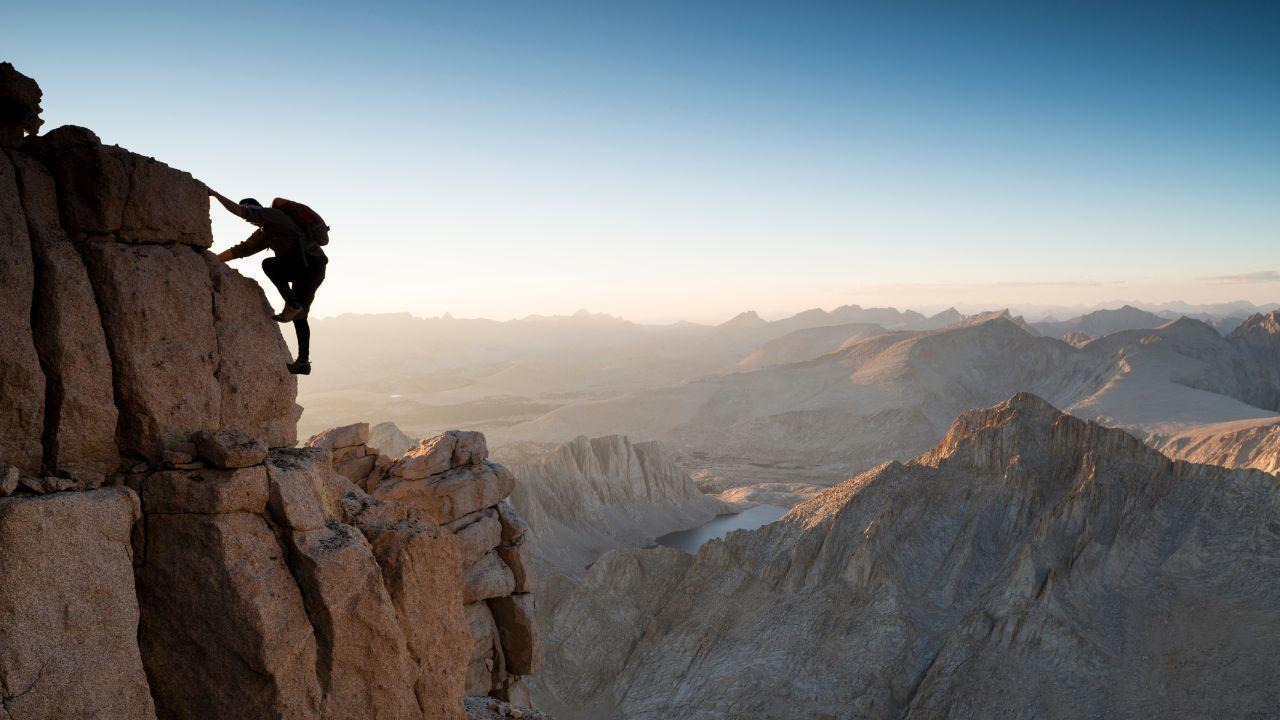
Post by: Kanchan Chandel
Have you ever wondered what it would be like to climb a giant rock wall without any ropes or safety gear? That’s exactly what free solo climbing is all about! It’s an exciting and daring sport where climbers use only their hands, feet, and their own bravery to climb steep cliffs.
Free solo climbing is when climbers ascend tall rock faces without using ropes or harnesses. Instead of relying on equipment, they depend on their strength, balance, and focus to navigate the challenging routes.
Imagine standing at the base of a massive cliff, looking up at the sheer rock face. A free solo climber starts at the bottom and carefully makes their way to the top, using cracks and edges in the rock to climb up. Every move they make requires careful planning and precision, as one wrong step could lead to a fall.
Safety is a big concern in free solo climbing. Even though climbers don’t use ropes, they spend a lot of time practicing and training. They study the rock formations and practice their moves over and over again until they feel ready to climb without any safety gear.
Famous free solo climbers like Alex Honnold have become well-known for their daring climbs. Alex Honnold, for example, climbed El Capitan in Yosemite National Park without any ropes. His climb was so impressive that it was featured in a documentary film called "Free Solo."
Free solo climbing isn’t just about physical strength. It’s also about mental strength and staying calm under pressure. Climbers need to be completely focused on their climb, without any distractions.
Although free solo climbing can be very risky, climbers who practice this sport believe it gives them a sense of freedom and accomplishment that they can’t get anywhere else. They say there’s nothing like reaching the top of a challenging climb and looking down at how far they’ve come.
In conclusion, free solo climbing is an extreme sport that requires a lot of courage, skill, and preparation. It’s not something everyone can do, but for those who love adventure and pushing their limits, it’s an exhilarating way to experience the thrill of climbing.
Preparing for free solo climbing is not just about physical strength—it's a meticulous process that requires careful planning and dedication. Here’s a look into how climbers get ready for this daring adventure:
- Training for Free Solo Climbing
Climbers undergo rigorous training sessions to build their strength and improve their technique. They focus on exercises that enhance their grip strength and agility, which are crucial for navigating steep cliffs without ropes.
- Practice for Free Solo Climbing
Practice makes perfect in free solo climbing. Climbers spend countless hours on smaller climbs, honing their skills and familiarizing themselves with different types of rock formations. This helps them develop a keen understanding of the terrain they will face during their ascent.
- Mental Preparation for Free Solo Climbing
Climbing without ropes requires exceptional mental focus and confidence. Climbers practice mental exercises to stay calm under pressure and to visualize their route before attempting it. This mental preparation is just as important as physical training.
- Route Planning for Free Solo Climbing
Before attempting a free solo climb, climbers meticulously plan their route. They study maps, evaluate potential challenges such as overhangs or loose rock, and identify safe resting points. This planning helps them anticipate difficulties and reduce risks during the climb.
- Assessing Conditions for Free Solo Climbing
Weather and rock conditions play a crucial role in free solo climbing safety. Climbers monitor weather forecasts closely and choose days when conditions are optimal—dry rock and minimal wind. They also inspect the rock surface for any signs of moisture or loose holds that could affect their ascent.
- Safety Measures for Free Solo Climbing
Despite the lack of ropes, safety is a priority for free solo climbers. Some wear climbing shoes with sticky rubber soles for better traction, and they often carry a small chalk bag to keep their hands dry and improve their grip. These small measures can make a big difference on challenging climbs.
- Learning from Experience for Free Solo Climbing
Experienced climbers often learn from their past climbs. They reflect on their successes and mistakes to improve their skills and decision-making for future climbs. Each climb is an opportunity to grow and become a better climber.

Free solo climbing is an exciting but risky activity where climbers scale steep cliffs without any ropes or safety gear. While it offers a sense of freedom and adventure, it also poses serious dangers that climbers must carefully consider.
Imagine climbing a tall rock wall with nothing to catch you if you slip. That’s the essence of free solo climbing. Without ropes or harnesses, climbers rely solely on their skill and strength to stay safe. This means one wrong move could lead to a fall, potentially causing severe injuries like broken bones or worse.
Climbers must stay incredibly focused throughout their ascent. Even a momentary lapse in concentration could have disastrous consequences. Every move must be calculated and deliberate to ensure a safe climb.
Weather conditions and the condition of the rock itself play crucial roles in the safety of a climb. Wet or loose rock can make holds slippery and less reliable, increasing the risk of a fall. Experienced climbers assess these factors before attempting a climb.
Successful free solo climbers train extensively to build strength and improve their climbing technique. They also prepare mentally, practicing visualization and relaxation techniques to stay calm under pressure.
Despite the lack of safety gear, safety is always a top priority for free solo climbers. They meticulously plan their routes, sometimes rehearsing climbs multiple times before attempting them without protection. This careful preparation helps mitigate risks as much as possible.
Beyond the physical risks, free solo climbing presents a significant psychological challenge. Climbers must manage their fear and anxiety to maintain focus and make decisions calmly under stress.
Have you ever heard of the brave individuals who climb tall mountains without any ropes or safety gear? These fearless adventurers are known as free solo climbers. They rely on their skills, strength, and courage to conquer steep cliffs, making it look like a daring dance with gravity.
One of the most famous free solo climbers is Alex Honnold. He gained worldwide fame for his incredible ascent of El Capitan in Yosemite National Park. Imagine climbing a vertical rock face as tall as a skyscraper—without any ropes or safety harnesses! Alex’s achievement was a testament to his unparalleled determination and climbing ability.
Dean Potter was another renowned free solo climber who was known for his bold and creative approach to climbing. He explored new routes and sought to blend different adventure disciplines like base jumping with solo climbing. His fearless spirit and innovative approach inspired many in the climbing community.
Catherine Destivelle made history as one of the first female climbers to achieve significant feats in free solo climbing. Her passion and persistence paved the way for women climbers to pursue their dreams in a traditionally male-dominated sport. She showed that with dedication and skill, anything is possible.
Ueli Steck was known for his exceptional speed and precision in climbing. While not exclusively a free solo climber, he set records for fast ascents on some of the world’s most challenging peaks. His technique and focus were legendary, inspiring climbers to continually push their limits.
These legendary climbers have left an indelible mark on the world of free solo climbing. They have shown us the power of courage, perseverance, and a deep connection with nature. Their stories continue to inspire new generations of climbers to embrace challenge and pursue their passions with unwavering determination.
When it comes to free solo climbing, safety is paramount. Even though climbers don’t use ropes or harnesses, they take many precautions to stay safe.
Before attempting a climb, free solo climbers spend a lot of time planning. They study the route carefully, looking for the best holds and figuring out where it might be tricky. This helps them know what to expect and how to handle any challenges they might face.
Climbers also need to be in great shape both physically and mentally. They train their bodies to be strong and flexible so they can hold onto the rock firmly. Mentally, they practice staying calm and focused, which is really important when you’re hundreds of feet up with no ropes.
Knowing the rock and the weather conditions is crucial too. Free solo climbers pay close attention to the texture of the rock and how it changes as they climb. They also keep an eye on the weather forecast to make sure they won’t encounter unexpected rain or wind that could make the climb dangerous.
Even though there’s no safety gear, climbers do take some safety measures. Some climbers will climb a route with ropes first to practice and make sure they can do it safely without them. This helps them feel more confident when they do the climb for real.
During the climb, focus is key. Climbers have to concentrate on every move they make to stay balanced and secure. One slip could mean a fall, so they have to be really careful.
Imagine standing at the base of a tall mountain, looking up at its rocky face. Now, picture yourself climbing that mountain without any ropes or safety gear. That’s what free solo climbing is all about—it’s a thrilling adventure that requires strength, skills, and courage.
Free solo climbing is not just a sport; it’s a daring journey that challenges climbers to push their limits. It inspires us to overcome fears and embrace the thrill of exploration. Watching climbers scale cliffs with only their bare hands and footwork can ignite a spark of curiosity and ambition in those who dream of adventure.
To become a free solo climber, one must cultivate both physical and mental discipline. Training involves practicing on easier climbs, improving technique, and building strength. Climbers also learn to stay calm and focused under pressure, as every move must be deliberate and precise.
While free solo climbing may seem risky, experienced climbers prioritize safety. They meticulously study the route, assess potential hazards, and ensure they are prepared for any challenge they might face. Safety is not just about avoiding falls but also about respecting nature and the environment.
Many famous climbers like Alex Honnold have shown us what it means to pursue our dreams with determination and passion. Their achievements inspire us to set goals, work hard, and never give up—even when faced with seemingly impossible challenges.
For young adventurers, free solo climbing can be a source of inspiration. It encourages them to explore the outdoors, learn new skills, and appreciate the beauty of nature. While not everyone will become a free solo climber, the lessons of courage, perseverance, and respect for the environment are valuable for all.
Free solo climbing is an exhilarating sport where climbers ascend steep cliffs without ropes or safety gear. It demands immense strength, skills, and courage, relying solely on their ability to grip and balance on rock faces. Safety is crucial despite the risks, with climbers meticulously planning routes and practicing extensively. Famous climbers like Alex Honnold have achieved renown for their daring feats, inspiring others with their determination and passion. This extreme sport challenges climbers both physically and mentally, emphasizing the importance of focus and preparation. While it offers a sense of freedom and accomplishment, it requires respect for nature and careful consideration of risks.
While free solo climbing is an exciting sport celebrated for its bravery and achievements, it is inherently risky and not suitable for everyone. Climbers who engage in free solo climbing undertake significant preparation and training to minimize risks. We encourage all readers to prioritize safety and respect the environment when pursuing any adventure activity. Remember, safety and preparation are paramount in all outdoor pursuits.
#trending #latest #FreeSoloClimbing #ExtremeAdventure #CourageousClimbers #RockClimbing #NoRopes #OutdoorChallenge #DaringFeats #AlexHonnold #MountainClimbing #SafetyFirst #PushingLimits #NatureAdventure #InspiringClimbers #AdventureSport #MindOverMatter #VerticalChallenge #breakingnews #worldnews #headlines #topstories #globalUpdate #dxbnewsnetwork #dxbnews #dxbdnn #dxbnewsnetworkdnn #bestnewschanneldubai #bestnewschannelUAE #bestnewschannelabudhabi #bestnewschannelajman #bestnewschannelofdubai #popularnewschanneldubai

Sheikh Sultan bin Mohammed Al Qasimi condoles with Sheikh Saud bin Rashid Al Mualla on the death of his mother, Sheikha Hessa bint Hamid Al Shamsi....Read More.

Nigerian boxer Gabriel Oluwasegun Olanrewaju dies after collapsing in the ring during a fight in Ghana. He was 40. Tragic loss for the boxing community....Read More.














Ananya Panday Shines at IPL 2025 with Stunning Dance Performance
Bollywood star Ananya Panday dazzled the crowd at Wankhede Stadium with her energetic dance before M

Foreign Minister Joins Heritage Foundation Discussion in Washington
Dr. Abdullatif Al Zayani attended a session at the Heritage Foundation in Washington, discussing Bah

ChatGPT Hits 1 Million Users in an Hour with Ghibli AI Art
OpenAI's new image feature, creating Ghibli-style AI art, goes viral. ChatGPT added 1 million users

UConn Joins Top Seeds in Women’s Final Four
UConn, South Carolina, UCLA, and Texas are in the Women’s Final Four. It’s set to be an exciting sho

7 Free Ghibli-Style AI Image Editors to Try Now
Transform your images into Ghibli-style art with these 7 free AI tools. From dreamy landscapes to an